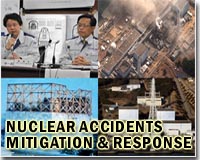| . |  |
. |
Osaka, Japan (AFP) March 19, 2011 Japan said Saturday it was close to restoring electricity to reactor cooling systems at a stricken nuclear plant as efforts to prevent dangerous radiation leaks reached a crucial phase. Electricity was expected to be reconnected to four reactor units at the Fukushima No. 1 plant on Saturday and to the remaining two on Sunday after damage from a huge earthquake and tsunami, the nuclear safety agency said. The announcement offered some hope of a breakthrough in efforts to prevent a full-blown meltdown at the troubled facility, although it is not yet clear whether the cooling system will work properly even if power is restored. Emergency services were also preparing to dump more water on overheating fuel rods in what the head of the UN International Atomic Energy Agency (IAEA) has described as "a race against time" to prevent a major disaster. Plant operator TEPCO has not ruled out the last-resort option of entombing the plant in sand and concrete as Russia did with the Chernobyl plant in 1986, but says it is still focusing its efforts on cooling the facility. The company said it had installed an external power line to the plant, located about 250 kilometres (155 miles) northeast of Tokyo, and was battling to reconnect reactor units, starting with the least damaged unit. "We are still working to lay the power line for a distance of 1.5 kilometres (one mile) to reconnect the reactor number two. We are struggling in this work." In the meantime a generator-powered water cooling pump is being used at one of the reactors, the nuclear safety agency said. TEPCO also said that its engineers had bored holes in the roofs of the buildings housing reactors five and six to avoid a potential explosion of hydrogen gas. Four of the plant's six reactor units -- numbers one to four -- have been in danger of spewing dangerous amounts of radioactivity, following a series of hydrogen explosions and fires at buildings housing the troubled reactors. The 9.0-magnitude earthquake last week, followed by monster tsunami waves and aftershocks, knocked out the power supply, including generators for emergency use, at the plant on the Pacific coast. Authorities have since struggled to keep the fuel rods inside reactors, and fuel storage containment pools, under water. If they are exposed to air, they could degrade further and emit large amounts of radioactive material. Japan's nuclear safety agency on Friday raised the Fukushima crisis level to five from four on the international scale of gravity for atomic accidents, which goes up to seven. The decision puts Fukushima on the same level as the 1979 accident at Three Mile Island in Pennsylvania and makes it the worst ever in Japan. "This is a very grave and serious accident," the Japanese head of the IAEA, Yukiya Amano, said Friday after meeting Prime Minister Naoto Kan in Tokyo. Japan has said radiation levels from the plant pose no health threat outside a 20-kilometre exclusion zone, despite slightly elevated levels in Tokyo earlier in the week. The IAEA said Friday that radiation levels detected in the Japanese capital did not pose any harm to human health. "Dose rates in Tokyo and other cities remain far from levels which would require action. In other words they are not dangerous to human health," said Graham Andrew, scientific and technical advisor to the head of the IAEA, which has sent a radiation monitoring team to Japan. Despite the reassurances, Britain, France and other countries have advised their citizens to leave Tokyo and many foreigners have fled the capital, fearing that a larger radiation leak might reach the sprawling city. Many nations have shifted embassies out of Tokyo, and the mood is jittery even far from Japan, with panic-buying of iodine pills in the United States, and Asian airports scanning passengers from Japan for radiation contamination.
Share This Article With Planet Earth
Related Links Bringing Order To A World Of Disasters A world of storm and tempest When the Earth Quakes
 Disaster-hit Japan hopes to cool reactors soon
Disaster-hit Japan hopes to cool reactors soonKitakami, Japan (AFP) March 19, 2011 Japanese engineers fighting to cool overheating reactors laid a power line into a stricken nuclear power plant on Saturday as hundreds of thousands of quake-tsunami survivors endured desperate conditions in the frozen north. In an updated toll, national police said at least 18,000 were dead or missing in Japan's worst natural disaster in 88 years. Just under 7,200 were confirmed killed, lost ... read more |
|
| The content herein, unless otherwise known to be public domain, are Copyright 1995-2010 - SpaceDaily. AFP and UPI Wire Stories are copyright Agence France-Presse and United Press International. ESA Portal Reports are copyright European Space Agency. All NASA sourced material is public domain. Additional copyrights may apply in whole or part to other bona fide parties. Advertising does not imply endorsement,agreement or approval of any opinions, statements or information provided by SpaceDaily on any Web page published or hosted by SpaceDaily. Privacy Statement |